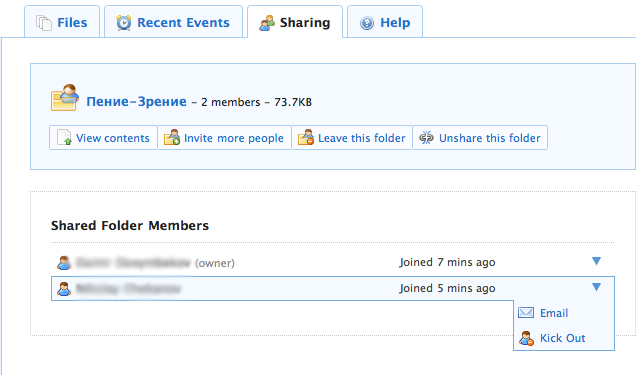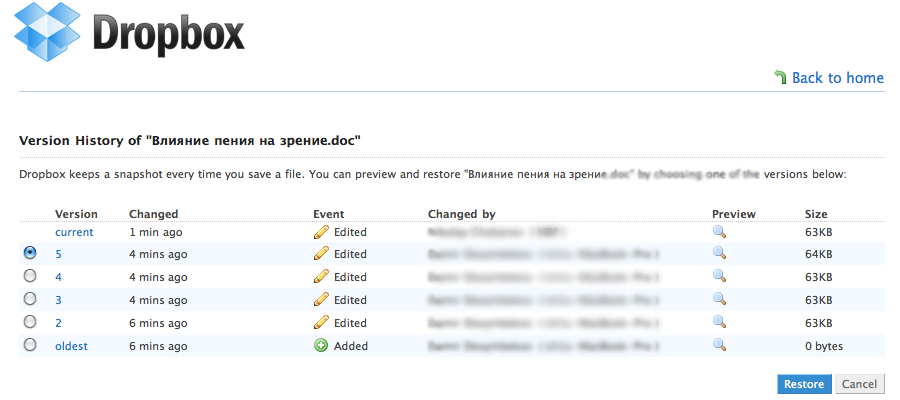Dropbox and document collaboration
Quite often they began to write on Habré about the non-standard use of Dropbox , especially I was pleased with the use case for synchronizing message history . Therefore, I want to share with the public the option of using Dropbox to collaborate on documents.
I work in a company that develops specialized biological software for pharmaceutical companies. By occupation, my colleagues and I have to deal with writing scientific articles, grants and other documents that we have to work on together.
Currently, the joint work on documents is carried out through e-mail. The scheme is the most primitive: one author makes changes and then forwards to the other co-authors, who in turn read and make their own changes and additions. Such a "ping-pong" generates a large number of letters with content like "Peter, this is the latest version of the document," and many versions. And of course, sooner or later someone gets confused and starts to rule an already irrelevant version. To catch such missteps, you have to spend extra time. Another reason why mail is used, and not some specialized tools like SharePoint is the ease of use, no need to learn to work in the new software.
')
Not so long ago, I discovered Dropbox, into which I immediately began to drop work files for work at home. You do not need to send the file to yourself every time by mail, and you still have to remember to send back the updated version to yourself. And later came the idea that Dropbox can be used to work together.
It is based on the ability to share individual folders for other users of the service. That is, you can create a folder, place the initial versions of documents in it, and then share it with the other co-authors, provided, of course, that they are Dropbox users. Then any update of files will immediately be displayed by other users, that is, the task of working with current versions will be solved. But there are a number of shortcomings, in particular when updating files, the change was not shown from whose side.

In addition, to work only with current versions of documents, you need to be able to track changes. Here Dropbox allows you, firstly, to view what changes were generally made in the folder: which files were added / deleted / changed.

And secondly, for each file, you can see the history of changes, and if necessary, roll back, or download the file of the desired version. This means that any changes will be saved. By the way, deleting a file, accidental or deliberate, is not a disaster, it is easy to recover a deleted file with one click.

What will happen if one of the co-authors is in a location where there is no Internet, and he has to use the current version of the document, while at that time the other co-author made his changes and updated the document (more precisely, it will update automatically)? When our first author returns online, a conflict will arise: an attempt to update the file, the version of which is higher than the one on hand. In such cases, Dropbox saves the conflicted file as a copy so that you can further make changes to the current version of the document, though by third-party means.
Summarizing the above, we can highlight the following advantages:
In general, the idea seems workable and works in theory, but you need to try it in real conditions, which I will try to do in the near future.
I work in a company that develops specialized biological software for pharmaceutical companies. By occupation, my colleagues and I have to deal with writing scientific articles, grants and other documents that we have to work on together.
Currently, the joint work on documents is carried out through e-mail. The scheme is the most primitive: one author makes changes and then forwards to the other co-authors, who in turn read and make their own changes and additions. Such a "ping-pong" generates a large number of letters with content like "Peter, this is the latest version of the document," and many versions. And of course, sooner or later someone gets confused and starts to rule an already irrelevant version. To catch such missteps, you have to spend extra time. Another reason why mail is used, and not some specialized tools like SharePoint is the ease of use, no need to learn to work in the new software.
')
Not so long ago, I discovered Dropbox, into which I immediately began to drop work files for work at home. You do not need to send the file to yourself every time by mail, and you still have to remember to send back the updated version to yourself. And later came the idea that Dropbox can be used to work together.
Folder sharing
It is based on the ability to share individual folders for other users of the service. That is, you can create a folder, place the initial versions of documents in it, and then share it with the other co-authors, provided, of course, that they are Dropbox users. Then any update of files will immediately be displayed by other users, that is, the task of working with current versions will be solved. But there are a number of shortcomings, in particular when updating files, the change was not shown from whose side.

Change tracking
In addition, to work only with current versions of documents, you need to be able to track changes. Here Dropbox allows you, firstly, to view what changes were generally made in the folder: which files were added / deleted / changed.

And secondly, for each file, you can see the history of changes, and if necessary, roll back, or download the file of the desired version. This means that any changes will be saved. By the way, deleting a file, accidental or deliberate, is not a disaster, it is easy to recover a deleted file with one click.

Conflict situations
What will happen if one of the co-authors is in a location where there is no Internet, and he has to use the current version of the document, while at that time the other co-author made his changes and updated the document (more precisely, it will update automatically)? When our first author returns online, a conflict will arise: an attempt to update the file, the version of which is higher than the one on hand. In such cases, Dropbox saves the conflicted file as a copy so that you can further make changes to the current version of the document, though by third-party means.
Results
Summarizing the above, we can highlight the following advantages:
- No special knowledge is required, it is enough to fill in the registration form and install the client, and everything else will occur automatically.
- No need to use mail or FTP to exchange versions of the document.
- All versions of the document are saved on the Dropbox server, because the necessary file will be accessible from anywhere where there is internet and you can not be afraid of deleting files
- There is no system for resolving conflict situations. Now, when a conflict occurs, the files will have to be compared manually, even though using MS Word.
- Security issues - if one of the collaborators account is hacked, your information will be stolen. In addition, it is not acceptable for everyone that articles and other documents that essentially describe the latest research are kept in the hands of third parties.
- A fairly primitive version control system.
In general, the idea seems workable and works in theory, but you need to try it in real conditions, which I will try to do in the near future.
Source: https://habr.com/ru/post/90583/
All Articles